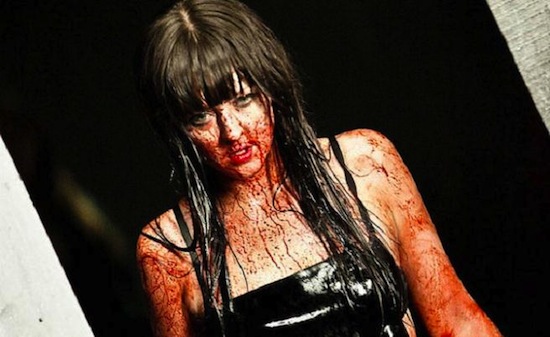Alongside Peter Strickland’s excellent Berberian Sound Studio, Jen and Sylvia Soska’s American Mary was easily the most original film of 2012s Frightfest. Taking the world of body modification as its theme, the film stakes a claim to territory generally unmapped by Western horror films, although it can be found in the likes of Takeshi Miike’s Audition and the south-Korean Bong Man-dae’s Cinderella. Todd Browning’s Freaks and Twin Peaks era David Lynch, are also evident in the mix, as well as the kind of humour to be found in early John Waters films. In terms of its slick production values, the film is a massive leap from the ‘twisted twins’ previous feature, the grindhouse-inspired Dead Hooker in a Trunk, and although it never quite lives up to its original promise, it represents a further development of a unique and specifically female sensibility – two distinct aspects that the horror genre is sadly lacking in at present.
Katherine Isabelle, who excelled as a teen-werewolf in the film Ginger Snaps and its two sequels, is compelling in the role of Mary Mason, an attractive eastern-European medical student seeking the American dream of financial success. Struggling with her finances, whilst fielding calls from her grandmother in Budapest and dealing with the unsolicited attentions of deeply unpleasant male surgeons, Mary finds herself drawn deeper into an underground world of illicit body-modification surgery. Vancouver-based burlesque artist, Tristan Risk, plays Beatrice Johnson – a sympathetic character who has been surgically altered to look like Betty Boop. Beatrice introduces Mary to her first real body-modification operation in the person of Ruby Realgirl (Paula Lindberg), who coyly requests that her sexual organs be sealed shut so that she might fully resemble a doll. She tells a visibly shocked Mary: "I’ve never had any of these surgeries to become a sexual object…no one looks at dolls in a sexual manner…. a doll can be naked and never feel shy or sexualised or degraded, that’s what I want."
The spiking of her drink and subsequent rape of Mary by her tutor marks the beginning of a major change in her character. Despite the fact that there are far more bloody moments in the movie, the way the camera dwells upon Mary’s stillness during the assault makes it perhaps the film’s most disturbing scene. Jen and Sylvia Soska have gone on record as saying that part of the film’s inspiration draws from their experiences as actors with casting directors and the ‘disgusting’ things that they often get away with. In choosing to use the medical world, in particular that of surgeons (who refer to themselves jokingly as ‘slashers’) to portray the inequality and abuse of power by men within the film-making industry, the Soskas establish a unique and macabre avenue for revenge by the film’s heroine. Once that moment of drug-enforced stillness and involuntary acquiescence has passed, Mary becomes the primary empowered figure of the piece, exacting a hideous but not undeserved revenge on Doctor Grant.
Many critics writing in the mainstream-press have questioned whether certain aspects of the film automatically rule it out from being perceived as a ‘feminist’ work. A scene in which Mary does an erotic dance whilst slowly pouring blood over herself is usually cited as the main example, although Katherine Isabelle’s dress sense – even when performing surgery – could similarly be called into question. Whilst it would be disingenuous to deny that the erotic dance scene leaves viewers feeling somewhat uncomfortable, it somewhat misses the point to suggest that this negates the value of the female perspective of the twin directors. The Soska sisters are uber-horror fans and horror has always had a strong prurient element, often displaced as violence towards women. Horror films are primarily an evocation of Thanatos and Eros, a celebration of sex and death – the two human impulses that could be seen as the main driving forces of modern society. In an interview, Sylvia Soska comments on the scene in question, saying: ‘‘I was only gonna put on a little spray, but she looked so good doused in blood, we kind of went crazy with it… but aesthetically it looked good.’
In this sense what sets American Mary apart from the majority of other horror films is the inversion of the usual power relationships between men and women. Mary becomes empowered, as well as both feared and respected by her underworld associates, precisely because she is both beautiful and skilled as a surgeon. A scene in which a character tells Mary how he wished he had known her when he enacted revenge on a youth who was involved in the death of his mother reveals the awe in which he holds her. Ultimately, American Mary accomplishes something of a different order entirely to other recent films which similarly could be termed feminist horror.
Lucky McKee’s The Woman largely eschews the female point of view in order to present a dark female, near Neanderthal archetype who, surprisingly, turns out to be the heroine of the piece by the end of the film. Richard Bates Jr’s Excision is told largely from a female point of view, but the character of Pauline is too in the grip of her own mental illness to be perceived as in control of her fate. Perhaps the best other example of a feminist character in a horror film that I can think of would be Jennifer in Frank Henenlotter’s Bad Biology. Born with a hypersexualised anatomy and the ability to give birth to disposable, mutant babies mere minutes after the culmination of the sexual act, Jennifer is an amazing character, self-possessed to the point where she exists in a place far beyond any usual sense of morality, conventional or otherwise. It is in such rare company that I would consider American Mary to reside. As a horror fan, I can hardly wait to see what the Soska sisters’ next move will be.
American Mary is out on DVD now



